Policy and Basic Approach
Environmental Policy
Our Group has established the Environmental Policy as a policy related to environmental issues pertaining to our Group (including greenhouse gas (GHG) emissions). Our Group's Environmental Policy is described on the following page.
Environmental Vision for 2050 (net zero)
Our Group relies upon the earth’s natural resources and energy in order to do business. However, doing business will generate garbage and air and water emissions. For this reason, we believe it is important for our Group to adhere to environmental laws and regulations, conduct business in an environmentally friendly manner, and engage in initiatives that reduce the environmental impact on the entire society through our products and services.
In line with the government’s 2050 Carbon Neutral Declaration and subsequent
presentation of its
target of reducing GHG by 46% or more (compared to fiscal 2013) by 2030, the
Group set 2050 as our
target for taking on the challenge of carbon neutrality, and 2030 for a 46%
or more reduction in
CO2 emissions (compared to fiscal 2013). In fiscal 2023, we have
achieved a 48% reduction
in CO2 emissions ahead of schedule. To acquire SBTi certification
(standards equivalent to
1.5°C scenario targets), in February 2024, we made a commitment to develop
targets and revised the
targets as follows.
• 2050 target: Taking on the carbon neutrality challenge
• 2030 target: Reducing GHG emissions
“Scope 1+2: Reducing GHG emissions by 48% or
more
(compared to
fiscal 2021)”
“Scope 3: Reducing GHG emission by 25% or
more
(compared to
fiscal 2021)”
Taking on the Challenge of Zero GHG Emissions
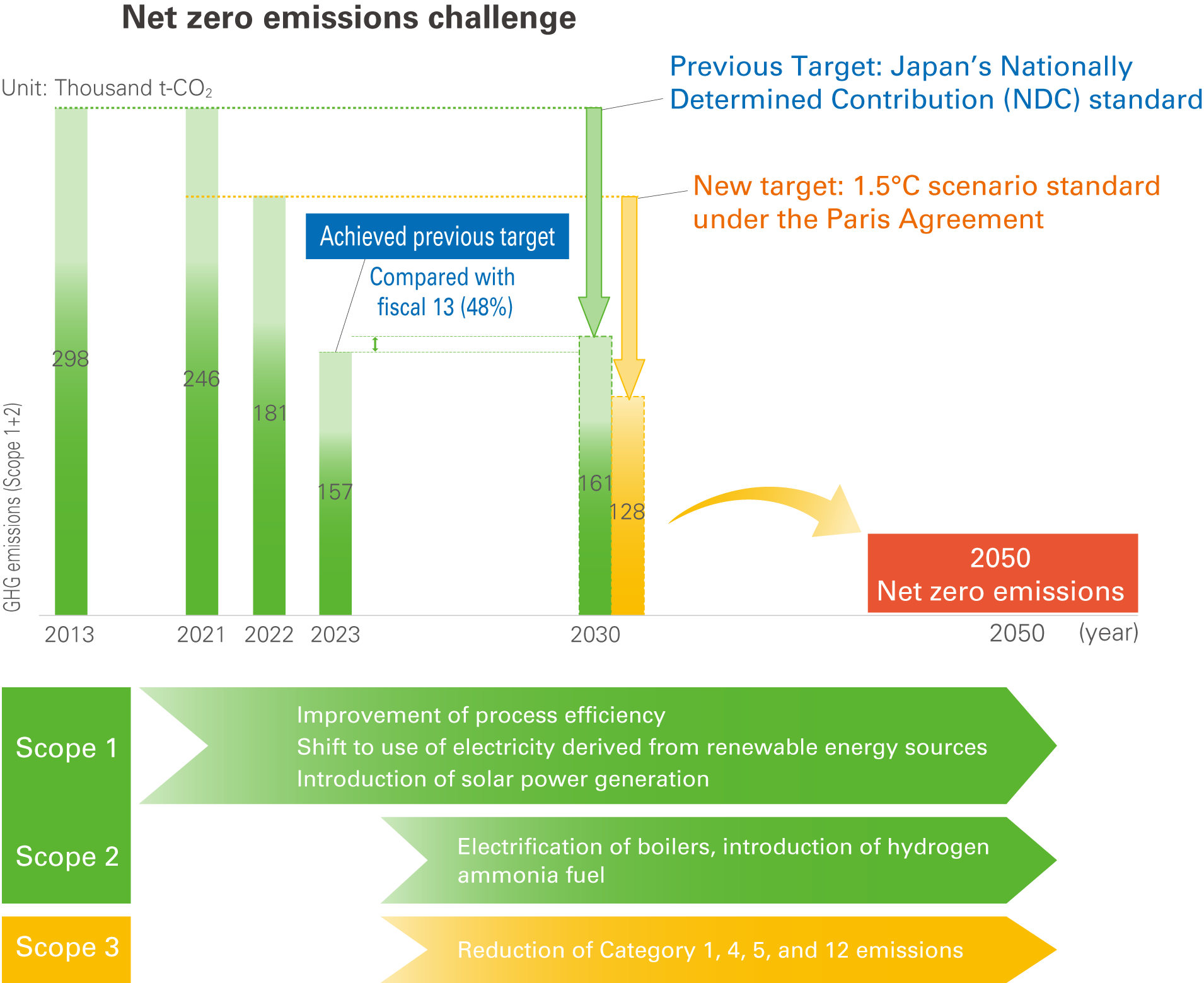
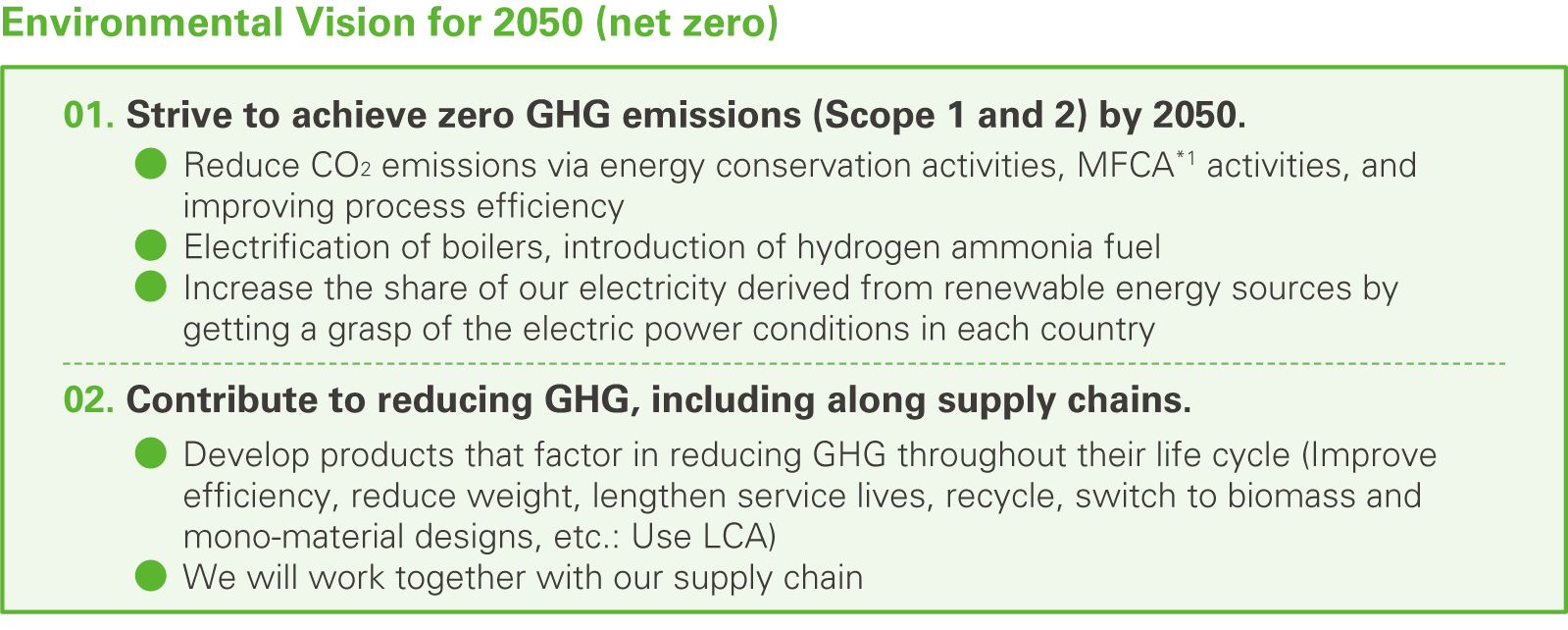
- *1 Acronym for Material Flow Cost Accounting, an environmental management and accounting tool for companies to improve cost efficiency and reduce environmental impact at the same time. Our Group utilizes this method as an analysis tool.
Structure (Governance)
The structure for supervision and management of environmental issues pertaining to our Group (including greenhouse gas (GHG) emissions) is described on the following page.
Risk Management
The identification, assessment, and management of risks and opportunities related to environmental issues pertaining to our Group (including greenhouse gas (GHG) emissions) are carried out in accordance with the risk management system and risk management process described on the following page.
Metrics and Targets
In line with the government’s 2050 Carbon Neutral Declaration and presentation of its 2030 target, we have been working to reduce CO2 emissions by 2030 with the goal of “reducing emissions by 46% or more (compared to fiscal 2013),” and we were able to achieve the goal ahead of schedule with a 48% reduction in CO2 emissions in fiscal 2023.
To acquire SBTi certification (standards equivalent to 1.5°C scenario targets), in February 2023, we made a commitment to develop targets.
For our medium-term GHG (Scope 1 + Scope 2) reduction target that we aim to achieve by 2030, we have set a new target of 48% or more reduction compared to fiscal 2021.
We will also set a Scope 3 reduction target by the end of fiscal 2024 and work to reduce emissions in the supply chain.
Entire the Group of Sumitomo Bakelite Co., Ltd.
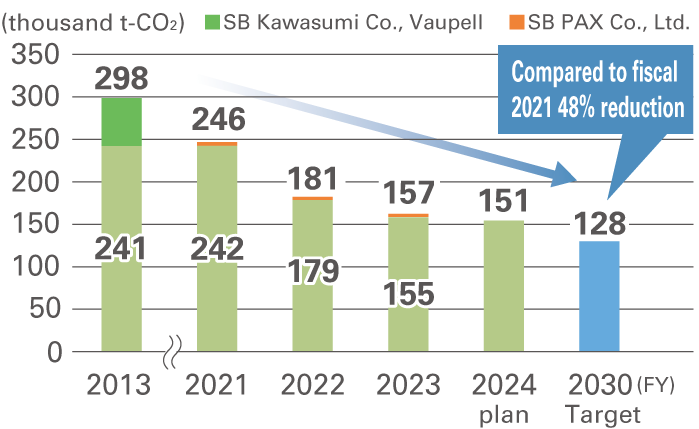
|
|
Main Initiatives
Activities of the Carbon Neutrality Promotion Committee
After the announcement by the government of its 2050 Carbon Neutral Declaration and 2030
targets, our
Group revised its plans as mid- to long-term targets, and has now set the following new
targets to acquire
SBTi certification.
• 2050 target: Taking on the carbon neutrality challenge
• 2030 target: Reducing GHG emissions by 48% or more (compared to fiscal 2021)
The Carbon Neutrality Promotion Committee recaps each year’s progress toward medium- to long-term environmental targets at the end of the fiscal year and determines the targets for the following fiscal year. It carries out its activities with the approval of the Sustainability Promotion Committee, which serves as its parent body. Two subcommittees were established within the committee in order to achieve its objectives, and these subcommittees work to reduce our environmental impact.
The Life Cycle Subcommittee aims to establish production systems with minimal environmental impacts through scientific, quantitative, and objective assessments of environmental impacts, from the R&D phase onward.
With the global trend toward achieving carbon neutrality, the approach to LCA (Life Cycle Assessment)—which assesses products over an extended period of time from their raw materials through to use and disposal—has become indispensable, and “LCA” has become a common term when engaging in dialogue with customers and suppliers.
In light of these circumstances, to provide an opportunity to learn about basic knowledge of the social background of LCA, the basics of LCA methods and our initiatives, the “LCA Basics” e-learning course was arranged for the first time in FY2023 for employees under the jurisdiction of the head office, with 1,725 employees taking the course.
Each R&D department decides a theme and works on it with an awareness of Life Cycle Assessment (LCA), from raw material extraction to final disposal (cradle to grave). In fiscal 2023, we worked toward the target of “retaining at least at 25% of all researchers” as qualified R&D personnel capable of understanding LCA and calculating the carbon footprint (CFP) of products. To this end, we organized LCA introductory courses, LCA training courses and LCA practice courses (comprehensive education and tutorials related to LCA) online, and maintained a target of 32% in fiscal 2023. Starting from fiscal 2023, guidance officers were also selected from qualified personnel for each location, to boost the level of LCA initiatives at each location. Starting from fiscal 2023, guidance officers were also selected from qualified personnel for each location, to boost the level of LCA initiatives at each location.
In addition, we also plan on establishing a system enabling us to speedily provide LCA information, from raw material extraction to factory gate (Cradle to Gate), on all of our Group’s products by the end of fiscal 2024, in response to the rapid increase in inquiries from customers regarding LCA since the Japanese government’s October 2020 net zero greenhouse gas emissions declaration. Initiatives in Japan achieved 93% of the target at the end of fiscal 2023 (92% of the plan). These initiatives will also be rolled out at overseas plans during fiscal 2024.
The CN Technology Review Subcommittee has established a system for continuously soliciting and implementing energy conservation ideas, and is promoting voluntary energy conservation activities at domestic sites.
In fiscal 2023, the subcommittee successfully reduced energy consumption by as much as 2,951 kL (114,369 GJ) in crude oil equivalent, or 5,696t-CO2, compared with fiscal 2021, primarily by reducing city gas and electricity consumption. Outside of Japan, the subcommittee worked to ensure a similar level of activities as in Japan and continued to promote the roll out of activity methods and best practices. Outside of Japan, the subcommittee worked to ensure a similar level of activities as in Japan and continued to promote the roll out of activity methods and best practices. Outside of Japan, the subcommittee worked to ensure a similar level of activities as in Japan and continued to promote the roll out of activity methods and best practices.
In fiscal 2023, in line with the objectives of the CN Promotion Committee, the CN Technology Deliberation Subcommittee will formulate a plan and work toward the most recent 2030 target. In terms of energy conservation, we will build upon past efforts to set energy conservation targets and also to complete our reduction plans for each business site. In particular, the subcommittee will focus on creating a system across business sites in Japan for sharing energy conservation practices and technical information related to energy conservation in order to improve the level of energy-saving technology throughout our Company; and having the mother plants in Japan provide technical support to their affiliated sites through a tie-up with the Company-wide Energy Conservation Secretariat.
Climate Change Program Efforts, TCFD Initiatives, and Participation in GX League
CDP*1 (headquartered in London) is an international NGO established in 2000 in partnership with institutional investors from around the world. It carries out projects in which it sends out questionnaires to major companies and municipal governments around the world on issues such as climate change, water security, and forests, and that seek climate change strategies and specific declarations related to emissions of greenhouse gases.
With the CDP’s 2023 survey, survey activities were conducted on behalf of 740 institutional investors with net invested assets totaling 136 trillion U.S. dollars. More than 23,000 companies disclose environmental data on their initiatives for climate change programs via the CDP.
From 2022, the number of companies in Japan requested to disclose their information on climate change was expanded to all companies (1,841) listed on the Prime Market of the Tokyo Stock Exchange.
Upon responding to the CDP questionnaire for fiscal 2023, we received an A- rating for climate change and B rating for water security in February 2024. Having received requests for responses in fiscal 2024 regarding climate change and water security as well, we have responded.
The TCFD initiative, for which we expressed our agreement in February 2021, is introduced in [Information Disclosure Based on the TCFD recommendations (Response to Climate Change)].
As a new initiative, following our announcement of our support for the “GX
League*2 Basic
Concept” published by the Ministry of Economy, Trade and Industry in fiscal 2022, we became
a
participating company in the “GX League” in May 2023, and have set targets for the our
domestic group and
are working on the initiative.
(https://dashboard.gx-league.go.jp/en/company/9010701005073/)
Going forward, our group will continue to proactively disclose information on the risks and opportunities associated with climate change and fulfill its responsibility to account to all stakeholders.
We will move forward with environmental information disclosure as we contribute to the response to climate change through reduction of environmental impact, resource and energy conservation, management of chemical substances, and development of products that contribute to the environment.
- *1 CDP: Formerly “The Carbon Disclosure Project”. “CDP” is now the official name.
- *2 GX League: Established as a forum for cooperation between a group of companies and the government, universities, and academic institutions in order to meet greenhouse gas reduction targets and increase industrial competitiveness by using Japan’s goal of carbon neutrality by 2050 as an opportunity for economic growth.
Reducing Energy Use and CO2 Emissions
All of our domestic business sites have switched their purchased electricity to electricity derived from renewable energy sources at all manufacturing and research sites, which is significantly reducing CO2 emissions from fiscal 2022 onward.
We are also encouraging our overseas business sites to switch to electricity derived from renewable energy sources, and in fiscal 2023 some sites in parts of the China and Southeast Asia region made the switch.
With efforts to actively install solar power generation also playing a role, both energy usage per production amount value and CO2 emissions per production amount value were on a reduction trend during fiscal 2023.
We will continue with our plans to utilize renewable energy sources during fiscal 2024 and beyond, with the view to further reducing CO2 emissions.
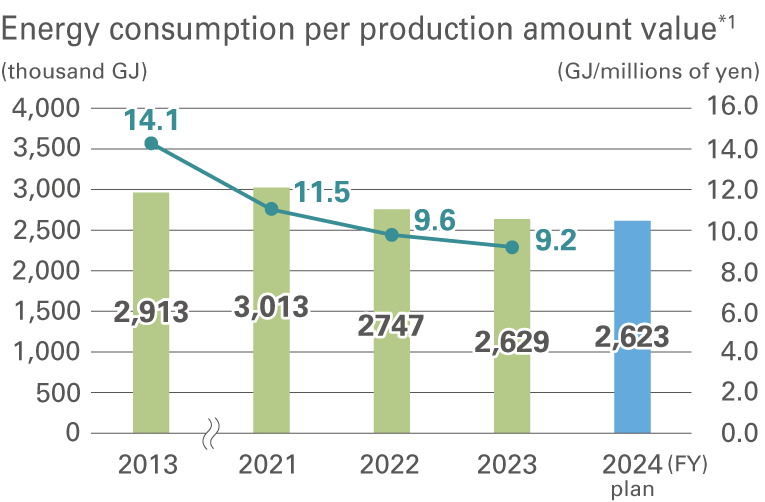
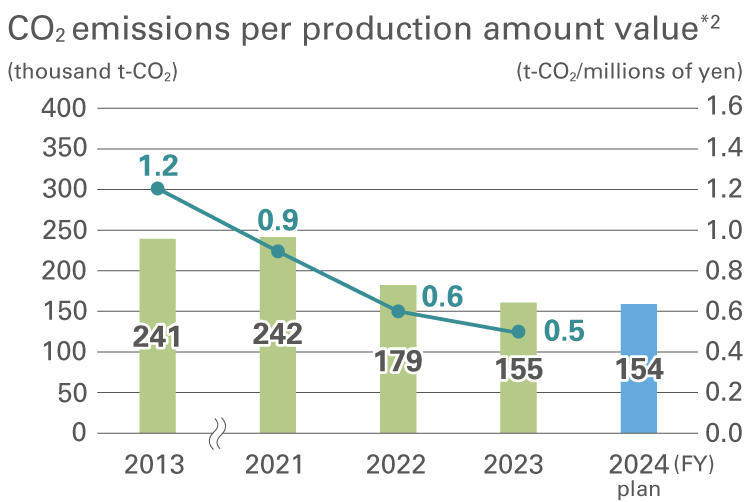
- *1, *2: Energy consumption and CO2 emissions per production amount value are determined using the following equation for sales per production amount value.
- • Energy consumption per production amount value = Energy consumption [thousand GJ] / Net sales [millions of yen]
- • CO2 emissions per production amount value = CO2 emissions (Scope1+Scope2) / Net sales [millions of yen]
- *1: From disclosure for the current period, the unit for energy consumption has been changed from crude oil equivalent (kL) to calorific value (GJ), including past fiscal years. The heat conversion coefficient for electricity consumption, including that in the past, has been changed to 3.6 GJ/thousand kWh.
Initiatives for Reducing Emissions During the Production and Sales Stages (use of Renewable Energy)
At our domestic business sites, we have switched from purchased electricity to electricity derived from renewable energy sources at all major business sites. We are also encouraging our overseas business sites to make the switch, and are actively installing solar power generation. As a result, our global CO2 emissions reduced by the use of renewable energy sources came to 32% of the total in fiscal 2023.
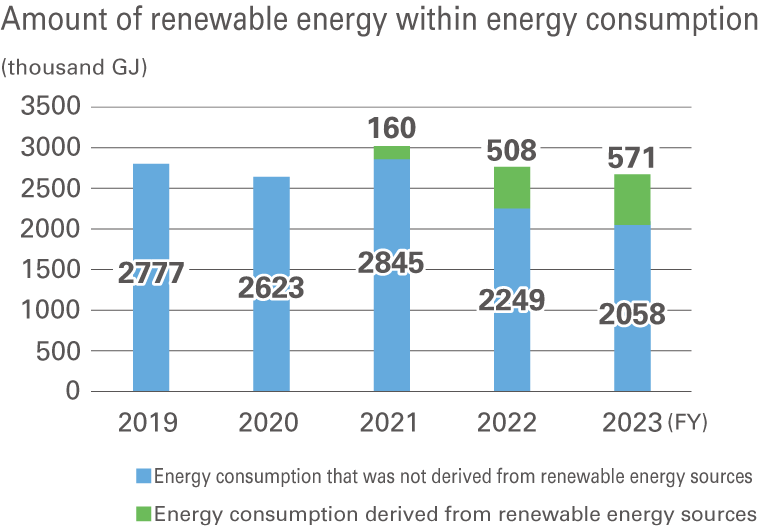
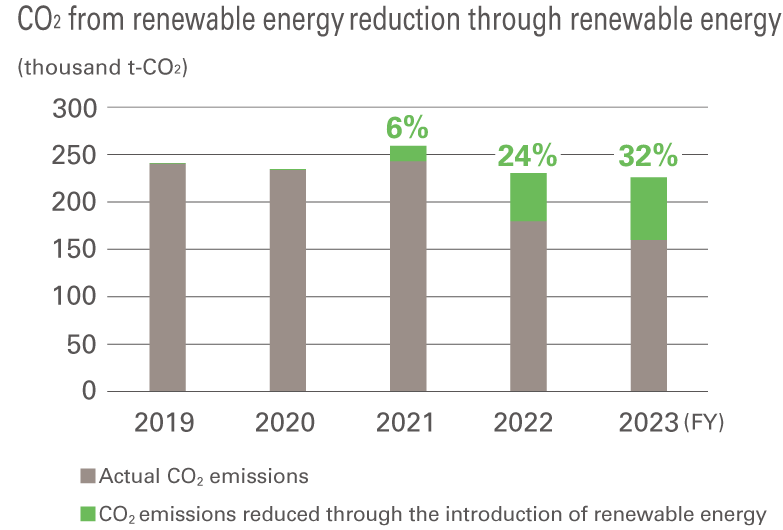
Initiatives for Reducing Emissions During the Production and Sales Stages (Excluding Use of Renewable Energy)
We have focused on fuel conversion from petroleum-based fuels to natural gas from an early stage.
Natural gas reduces SOx and NOx emissions as well as CO2 emissions by about 30%, compared to petroleum-based fuels.
In domestic business sites, we began switching over from around 2005. And in 2009, most of our plants directly operating under the group management had been converted to natural gas (city gas). Even subsidiaries that were slow converting due to certain infrastructure issues are now moving ahead with initiatives for gas conversion.
Overseas, business sites in North America and Europe were early in converting to natural gas, but sites in China and other Asian regions have also been gradually converting to natural gas, and by 2023, most business sites had completed the fuel conversion.
Currently, natural gas and other energy sources account for around 87% of the fuel used by the entire the Group of Sumitomo Bakelite Co., Ltd., but we are aiming to achieve 90% or more by 2027 by moving ahead with conversion at our domestic subsidiaries.
Scope 3 Data Disclosure
In 2015, our Group began calculating and disclosing Scope 3 emissions in the supply chain of business sites belonging to Group companies in Japan because of the growing importance of understanding and reducing CO2 emissions covering the entire supply chain. In fiscal 2018, we enlarged the scope to cover overseas business sites.
Both in Japan and overseas, Category 1 “Purchased goods and services” accounted for a large portion of CO2 emissions, and reducing these remains a challenge going forward.
In fiscal 2024, we set a new Scope 3 reduction target and have been accelerating our efforts to acquire SBTi certification.
Scope3 CO2 Emissions and Emissions in Each Category
(At Sites in Japan
and Overseas)
| No. | Category |
Emissions (thousand t-CO2/year) |
|---|---|---|
| 1 | Purchased goods and services | 718 |
| 2 | Capital goods | 65 |
| 3 | Fuel- and energy-related activities not included in Scope 1 & 2 | 39 |
| 4 | Upstream transportation and distribution | 61 |
| 5 | Waste generated in operations | 6 |
| 6 | Business travel | 2 |
| 7 | Employee commuting | 5 |
| 8 | Upstream leased assets*1 | - |
| 9 | Downstream transportation and distribution*2 | - |
| 10 | Processing of sold products*2 | - |
| 11 | Use of sold products*2 | - |
| 12 | Disposal of sold products*2 | 40 |
| 13 | Downstream leased assets*1 | - |
| 14 | Franchises*1 | - |
| 15 | Investments | 11 |
| Scope 3 Total | 947 | |
| Scope 1 (All direct emissions) | 80 | |
| Scope 2 (Indirect emissions associated with purchased power and steam) | 75 |
- Calculation method: We calculated the amount of emissions based on the Emissions Intensity Database for Calculating Greenhouse Gas Emissions of Organizations through the Supply Chain Ver. 3.4 issued by the Ministry of the Environment and the Ministry of Economy, Trade and Industry of Japan, using the emission coefficients stated in this database, and in the IDEA Ver. 3.3 Carbon Footprint Communication Program Basic Database developed jointly by the National Institute of Advanced Industrial Science and Technology and the Japan Environmental Management Association for Industry.
- *1: Not applicable due to business characteristics
- *2: Not calculated
- * See the organizations listed in Editorial Policy regarding those included in the data.
Response to the Fluorocarbon Emissions Control Act
Details of the “Fluorocarbon Emissions Control Act” that was enacted in April 2015 and further enhanced in April 2020 have been provided to each business site to ensure that they conduct regular quick inspections of the commercial air conditioners and freezer systems under their possession, and regular inspections as required by law for equipment with a rated output of 7.5 kW or higher. Given that there are a large number of air conditioners, particularly for office use, we are also working on strengthening management aspects, such as conducting annual inspections through internal audits to prevent omissions and missing inspections during upgrades.
We are also promoting the switch to refrigerants with zero ozone depletion potential and low global warming potential, with a view to preventing depletion of the ozone layer and curbing global warming.
Existing facilities are regularly inspected on a yearly basis for the amount of leakage in accordance with the “Fluorocarbon Emissions Control Act,” to check that there are no leaks in amounts that are required to be reported.
We were also awarded the highest rank of "A" in the “Third JRECO CFC Control Measure Rating” that assesses efforts to comply with the Fluorocarbon Emissions Control Act run by the Japan Refrigerants and Environmental Conservation Organization, which aims to enlighten and promote compliance with the Act, together with the Ministry of Economy, Trade and Industry and the Ministry of the Environment.

